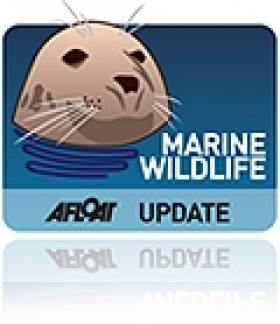Displaying items by tag: Belmullet
Ballyglass RNLI and Belmullet Tidal Pool Swimmers in north-west Co Mayo have won a Golden Welly for their recent fundraising efforts for the charity that saves lives at sea.
The RNLI award for Best Community Partnership Fundraiser, which is one of only six awards in all of Ireland and the UK, was announced last week at the RNLI’s virtual Mayday awards ceremony.
The volunteer lifeboat crew and the Belmullet swimmers were overjoyed to hear their deep-end dipping and donating earned them the prestigious Golden Welly.
The Golden Welly awards recognise and celebrate the fantastic work and contributions made to the RNLI’s annual Mayday fundraising campaign.
This year for the Mayday Mile, Michelle Healy and her mother Liz Healy, both on the committee of Belmullet Swim Club, came up with the idea of swimming a mile for the RNLI.
“There’s a great bunch of daily swimmers here in Belmullet, and they jumped at the chance to swim a mile to support the local lifeboat,” Michelle said. “We’re a coastal community and it's important we all pull together and support each other.”
Volunteer members of the Ballyglass RNLI crew joined in and swam in their full kit. Over five days during May, a total of 59 swimmers swam a collective distance of 74.11 miles in their Atlantic Ocean tidal pool, raising €2,016.
Pádraic Sheeran, Ballyglass RNLI’s lifeboat operations manager, said there has always been a great relationship between Ballyglass RNLI and Belmullet Swim Club with mutual respect and support at its core.
“Promoting water safety and saving lives at sea are common goals of the RNLI and the swim group and we’ve always worked well together.
“We are very thankful to Liz, Michelle and the group of swimmers and the great work they do and we’re delighted to accept an award that acknowledges and celebrates that effort. The funds raised will now help our volunteers as they continue to save lives at sea.”
Navy Joins Search For Missing Mayo Fisherman
#Missing - Naval Service vessels have joined the search for a fisherman missing off Mayo since last Friday 11 September.
As The Irish Times reports, 23-year-old Daniel Doherty is thought to have got into difficulty while baiting lobster pots on his boat Carra Rose off Belmullet.
The boat was located on the beach at Benwee Head, as previously reported on Afloat.ie, but there has been no other trace of Doherty since then.
Earlier today it was reported that both Ballyglass RNLI lifeboats remain involved in the multi-agency search for the lobsterman.
Search For Missing Lobsterman Off Mayo Coast
#Missing - Independent.ie reports on an ongoing search for a lobsterman feared missing off the Mayo coast since yesterday evening (Friday 11 September).
A fishing vessel was spotted on the beach at Benwee Head close to where the lone fisherman was thought to be working off Belmullet, but there was no sign of its occupant.
Searching was set to resume this morning with local lifeboats and coastguard teams includinng Shannon's Irish Coasrt Guard helicopter Rescue 115 on callout.
UCC Wave Energy Trials Central to New Maritime Cluster
#POWER FROM THE SEA - A €9 million Europe-wide wave energy trial programme is one of the key elements of a new Government programme designed to transform Ireland as a maritime nation.
According to The Irish Times, University College Cork's Hydraulics and Maritime Research Centre will run testing of wave energy, tidal energy and offshore wind energy devices across a network of sites in 12 European countries participating in the new marine renewables infrastructure network Marinet.
Irish test sites in the network include the national ocean test facility in Cork and centres operated by the Sustainable Energy Authority of Ireland (SEAI) at Galway Bay and Belmullet.
The UCC centre also forms part of the new Irish Maritime and Energy Resource Cluster (IMERC), launched last Friday by Taoiseach Enda Kenny.
The cluster comprises UCC, the Irish Naval Service, Cork Institute of Technology and the National Maritime College of Ireland with the initial aim of creating 70 new research jobs by 2014 in the areas of wave energy, green shipping and sustainability of ocean resources.
IMERC director Dr Val Cummins said: “The aim of IMERC is to promote Ireland as a world-renowned research and development location that will unlock Ireland’s maritime and energy potential."
The Irish Times has more on the story HERE.
- Irish Naval Service
- maritime
- Cork
- Galway Bay
- Belmullet
- National Maritime College of Ireland
- wind energy
- UCC
- Cork Institute of Technology
- renewable energy
- wave energy
- sustainable energy
- tidal energy
- network
- testing
- Sustainable Energy Authority of Ireland
- Taoiseach Enda Kenny
- SEAI
- Hydraulics and Maritime Research Centre
- Marinet
- devices
- Irish Maritime and Energy Resource Cluster
- IMERC
- Dr Val Cummins
Seal Sanctuary Sees Off Latest Releases
The Irish Seal Sanctuary celebrated the release of six grey seal pups from two different locations last weekend.
Dustin, Phoenix and Sean were released from Courtown Harbour, while Buddy Holly, Louise and Cookie were put into the water in Ballyferriter, Co Kerry with help from the Dingle Wildlife and Seal Sanctuary.
Sarah Forde, a volunteer at the Dingle sanctuary, told the Irish Independent that Buddy Holly was just 11kg in weight when he was brought in last October.
"Now, three months later, he's a healthy 44kg, the proper weight for a pup his age and in the next two years as he reaches maturity he'll grow to around 300kg," she said.
Louise and Cookie (pictured HERE) were found in a similar condition in beaches in Co Kerry after being abandoned by their mothers.
The Irish Seal Sanctuary's next release will be this Saturday 15 January when Cecil and Snowy, two seal pups rescued in Belmullet and rehabilitated at the sanctuary in Courtown, will be returned to the wild at Falmor Beach, Black Sod, Co Mayo.

























































